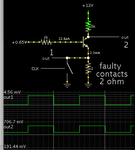debugtimog
Newbie level 5
Hi All,
I would like to ask to help me design a relay tester, that will buzz or light up if the contacts are,say more than 2 ohms. I dont want to use microprocessor, just a simple circuit, maybe a comparator? I want to switch it several times to power up the relay, and I would just know that the relays is faulty each time I press the power button.
Thanks in advance for your help.
I would like to ask to help me design a relay tester, that will buzz or light up if the contacts are,say more than 2 ohms. I dont want to use microprocessor, just a simple circuit, maybe a comparator? I want to switch it several times to power up the relay, and I would just know that the relays is faulty each time I press the power button.
Thanks in advance for your help.

